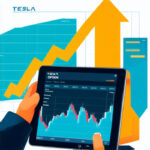Tesla Share Price Chart: An In-Depth Look at Market Fluctuations

Introduction to Tesla Share Price Chart
Overview of Tesla Inc.
Tesla Inc., founded in 2003 by Martin Eberhard and Marc Tarpenning, has grown exponentially under the leadership of Elon Musk. The company is a pioneer in electric vehicles (EVs), energy storage, and solar energy solutions. Tesla’s mission is to accelerate the world’s transition to sustainable energy. The company’s innovative products include vehicles like the Model S, Model 3, Model X, and Model Y, as well as energy products like Powerwall and Solar Roof. Tesla has not only disrupted the automotive industry but also positioned itself as a leader in the renewable energy sector.
Importance of Analyzing Share Price Charts
Analyzing share price charts is crucial for investors looking to make informed decisions. A share price chart provides a visual representation of a stock’s historical performance, helping investors identify trends and patterns. By studying these charts, investors can gauge the market sentiment, predict future price movements, and make strategic investment choices. For a high-profile company like Tesla, understanding its share price chart can offer insights into its market behavior, financial health, and overall performance. This knowledge is invaluable for both short-term traders and long-term investors.
Purpose of This Blog Post
This blog post aims to offer an in-depth analysis of the Tesla share price chart. We will explore the historical performance, key factors influencing the share price, and significant fluctuations over the years. Additionally, we will delve into technical analysis and compare Tesla’s share price chart with those of its competitors. Finally, we will provide expert opinions and forecasts to help investors make informed decisions. Whether you’re a seasoned investor or a newcomer, this comprehensive guide will equip you with the knowledge you need to navigate Tesla’s stock market journey.
Historical Performance of Tesla Share Price Chart
Early Years and IPO
Tesla went public on June 29, 2010, with an initial public offering (IPO) price of $17 per share. The company raised $226 million, marking a significant milestone in its journey. In its early years, Tesla’s share price experienced moderate growth, driven by the successful launch of the Roadster, its first electric sports car. However, the stock also faced volatility due to production challenges and skepticism about the viability of electric vehicles. Despite these hurdles, early investors who believed in Tesla’s vision were rewarded as the company continued to innovate and expand its product lineup.
Major Milestones and Stock Splits
Over the years, Tesla has achieved several milestones that have positively impacted its share price. The launch of the Model S in 2012, followed by the Model X and Model 3, garnered significant attention and drove stock prices higher. Tesla’s inclusion in the S&P 500 Index in December 2020 was another major milestone. The company has also undergone stock splits, the most recent being a 5-for-1 split in August 2020. These stock splits made Tesla shares more accessible to retail investors, contributing to increased trading volumes and higher market capitalization.
Recent Trends and Patterns
In recent years, Tesla’s share price chart has shown remarkable upward trends, reflecting the company’s strong market position and investor confidence. The stock experienced a surge in 2020, driven by record vehicle deliveries, positive earnings reports, and growing demand for electric vehicles. However, Tesla’s share price is not immune to market fluctuations. It has experienced periodic corrections, often triggered by broader market conditions or company-specific news. Despite this volatility, the overall trend remains positive, with Tesla continuing to outperform many of its competitors in the automotive and tech sectors.
Key Factors Influencing Tesla Share Price Chart
Market Sentiments and Investor Behavior
Market sentiments and investor behavior play a crucial role in shaping Tesla’s share price chart. Positive news, such as strong earnings reports or successful product launches, often leads to bullish sentiments, driving the stock price higher. Conversely, negative news or market rumors can trigger sell-offs and price declines. Investor behavior is also influenced by broader economic conditions, geopolitical events, and market trends. Understanding these dynamics is essential for predicting short-term price movements and identifying potential buying or selling opportunities in Tesla’s stock.
Company Financials and Earnings Reports
Tesla’s financial performance and quarterly earnings reports are key factors that influence its share price. Investors closely monitor metrics such as revenue growth, profit margins, vehicle deliveries, and cash flow. Positive financial results often lead to increased investor confidence and higher stock prices. On the other hand, any signs of financial instability or missed earnings expectations can negatively impact the share price. Tesla’s ability to consistently meet or exceed market expectations has been a significant driver of its stock’s long-term growth and investor loyalty.
Technological Innovations and Product Launches
Tesla’s commitment to innovation and its ability to bring cutting-edge products to market are significant factors influencing its share price chart. The company’s advancements in battery technology, autonomous driving, and energy solutions have positioned it as a leader in the EV and renewable energy sectors. Successful product launches, such as the Model 3 and the Cybertruck, have generated substantial media coverage and investor interest. These innovations not only drive revenue growth but also reinforce Tesla’s brand value and competitive edge, contributing to long-term shareholder value.
Regulatory and Environmental Policies
Regulatory and environmental policies significantly impact Tesla’s share price. Government incentives for electric vehicles, emissions regulations, and renewable energy policies can create favorable market conditions for Tesla. Conversely, adverse regulatory changes or trade restrictions can pose challenges. For example, stricter emissions standards in Europe have boosted demand for Tesla’s electric vehicles. On the other hand, trade tensions and tariffs can affect the company’s supply chain and profitability. Staying informed about regulatory developments is crucial for understanding the potential risks and opportunities for Tesla’s stock.
Case Studies: Significant Fluctuations in Tesla Share Price Chart
Impact of Elon Musk’s Announcements
Elon Musk’s public statements and announcements have a profound impact on Tesla’s share price. Known for his active presence on social media, Musk’s tweets and comments often lead to significant market reactions. For example, his 2018 tweet about taking Tesla private at $420 per share caused a temporary spike in the stock price, followed by regulatory scrutiny and legal challenges. Similarly, announcements about new products, technological advancements, or strategic partnerships can drive investor enthusiasm and lead to sharp price increases. Investors closely watch Musk’s communications for clues about Tesla’s future direction.
Effect of Global Economic Events
Global economic events and market conditions can lead to significant fluctuations in Tesla’s share price chart. Economic recessions, geopolitical tensions, and changes in interest rates can impact investor sentiment and stock valuations. For instance, the COVID-19 pandemic initially led to a sharp decline in global stock markets, including Tesla’s share price. However, as the economy began to recover and demand for electric vehicles surged, Tesla’s stock rebounded strongly. Understanding the broader economic context is essential for interpreting Tesla’s share price movements and making informed investment decisions.
Influence of Competitor Actions
The actions of competitors in the automotive and tech sectors can also influence Tesla’s share price chart. Announcements of new electric vehicle models or technological breakthroughs by competitors can affect investor perceptions of Tesla’s market position. For example, the entry of traditional automakers like Ford and General Motors into the EV market has led to increased competition and market volatility. Additionally, the performance of emerging EV companies like Rivian and Lucid Motors can impact Tesla’s stock. Investors must consider the competitive landscape when analyzing Tesla’s share price trends.
Technical Analysis of Tesla Share Price Chart
Moving Averages and Trendlines
Technical analysis is a valuable tool for understanding Tesla’s share price chart. Moving averages and trendlines help identify price trends and potential reversal points. The 50-day and 200-day moving averages are commonly used to gauge the stock’s momentum. When the stock price crosses above these moving averages, it is often seen as a bullish signal, while a cross below indicates potential bearishness. Trendlines, drawn by connecting significant price points, help visualize the direction of the stock’s movement. These technical indicators provide insights into Tesla’s short-term and long-term price trends.
Support and Resistance Levels
Support and resistance levels are critical concepts in technical analysis. Support levels represent price points where the stock tends to find buying interest, preventing further declines. Conversely, resistance levels are price points where selling pressure tends to emerge, capping price increases. Identifying these levels on Tesla’s share price chart helps investors make strategic decisions. For example, buying near support levels can offer a favorable risk-reward ratio, while selling near resistance levels can lock in profits. Understanding these key levels is essential for effective trading and investment strategies.
Volume and Momentum Indicators
Volume and momentum indicators provide additional insights into Tesla’s share price movements. Trading volume reflects the number of shares traded during a specific period, indicating the level of investor interest and market activity. High trading volumes often accompany significant price movements, confirming the strength of a trend. Momentum indicators, such as the Relative Strength Index (RSI) and Moving Average Convergence Divergence (MACD), help assess the stock’s buying and selling pressure. These indicators can identify overbought or oversold conditions, signaling potential price reversals or trend continuation in Tesla’s stock.
Comparing Tesla Share Price Chart with Competitors
Tesla vs. Traditional Automakers
Comparing Tesla’s share price chart with traditional automakers like Ford and General Motors highlights its unique market position. While traditional automakers have a long history and established market presence, Tesla’s focus on electric vehicles and innovation has set it apart. Tesla’s share price has significantly outperformed many traditional automakers, reflecting investor confidence in its growth potential. Factors such as higher profit margins, strong brand recognition, and advancements in autonomous driving technology contribute to Tesla’s superior market performance. This comparison underscores the transformative impact of Tesla’s business model on the automotive industry.
Tesla vs. Emerging EV Companies
Emerging electric vehicle companies like Rivian, Lucid Motors, and NIO represent a growing competitive landscape for Tesla. Comparing Tesla’s share price chart with these newcomers provides insights into the evolving EV market. While these companies have garnered attention and investor interest, Tesla’s established market leadership, production capabilities, and extensive charging infrastructure give it a competitive edge. Tesla’s ability to scale production, maintain quality, and innovate continuously sets it apart from its peers. This comparison highlights the opportunities and challenges Tesla faces as it navigates an increasingly crowded EV market.
Tesla’s Position in the Tech Sector
Tesla’s share price chart can also be compared with major tech companies like Apple, Google, and Amazon. As a leader in both the automotive and tech sectors, Tesla’s stock performance reflects its dual identity. The company’s advancements in software, artificial intelligence, and energy solutions align it with tech giants. Tesla’s market capitalization and stock valuation often draw parallels with leading tech companies, underscoring its innovative approach and growth potential. This comparison highlights Tesla’s unique position as a disruptor in multiple industries and its ability to attract tech-savvy investors.
Future Predictions for Tesla Share Price Chart
Expert Opinions and Forecasts
Expert opinions and forecasts provide valuable insights into the future trajectory of Tesla’s share price chart. Analysts consider various factors such as market trends, technological advancements, and financial performance to make predictions. While some experts remain bullish on Tesla’s long-term growth prospects, others caution about potential risks and market volatility. For example, analysts from investment firms like Goldman Sachs and Morgan Stanley regularly update their price targets and recommendations for Tesla. Monitoring these expert opinions helps investors stay informed about potential price movements and make data-driven investment decisions.
Potential Challenges and Opportunities
Tesla faces both challenges and opportunities that will influence its future share price. Challenges include increasing competition, supply chain disruptions, and regulatory changes. Additionally, the company’s ability to maintain production efficiency and meet growing demand is crucial. On the opportunity side, Tesla’s expansion into new markets, advancements in battery technology, and potential breakthroughs in autonomous driving present significant growth prospects. The company’s initiatives in energy storage and solar solutions also offer new revenue streams. Understanding these challenges and opportunities is essential for assessing Tesla’s long-term investment potential.
Long-term Investment Outlook
The long-term investment outlook for Tesla remains optimistic, driven by its strong market position, innovative capabilities, and commitment to sustainability. As global demand for electric vehicles and renewable energy solutions continues to grow, Tesla is well-positioned to capitalize on these trends. The company’s focus on reducing production costs, expanding its product lineup, and enhancing its technological edge will likely drive future growth. While market volatility and external factors may cause short-term fluctuations, Tesla’s long-term prospects make it an attractive investment for those willing to navigate the dynamic landscape of the EV and tech sectors.
Conclusion
Summary of Key Insights
In summary, Tesla’s share price chart reflects its remarkable journey from a niche electric vehicle manufacturer to a global leader in innovation and sustainability. Key factors influencing its share price include market sentiments, financial performance, technological advancements, and regulatory policies. Significant fluctuations have been driven by Elon Musk’s announcements, global economic events, and competitor actions. Technical analysis tools like moving averages, support and resistance levels, and volume indicators provide valuable insights into Tesla’s price trends. Comparing Tesla with traditional automakers, emerging EV companies, and tech giants highlights its unique market position.
Final Thoughts on Tesla’s Market Performance
Tesla’s market performance has been nothing short of extraordinary, characterized by rapid growth, innovation, and resilience. The company’s ability to navigate challenges, capitalize on opportunities, and consistently deliver value to shareholders underscores its strong market position. While the stock has experienced volatility, the overall trend remains positive, reflecting investor confidence in Tesla’s long-term potential. As the company continues to push the boundaries of technology and sustainability, it is likely to remain a key player in the automotive and tech sectors, attracting both retail and institutional investors.
Recommendations for Investors
For investors considering Tesla, it is important to stay informed about market trends, company developments, and broader economic conditions. Conducting thorough research, analyzing share price charts, and monitoring expert opinions can help make informed investment decisions. Diversifying your portfolio and managing risk is also crucial, given the inherent volatility of Tesla’s stock. Long-term investors who believe in Tesla’s vision and growth potential may find it a compelling addition to their portfolios. Ultimately, understanding the dynamic factors influencing Tesla’s share price will enable investors to navigate the market with confidence and achieve their financial goals.

Laura Henderson is an enthusiast and has been writing on cutting-edge topics for years.







